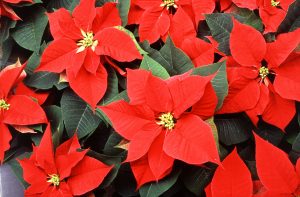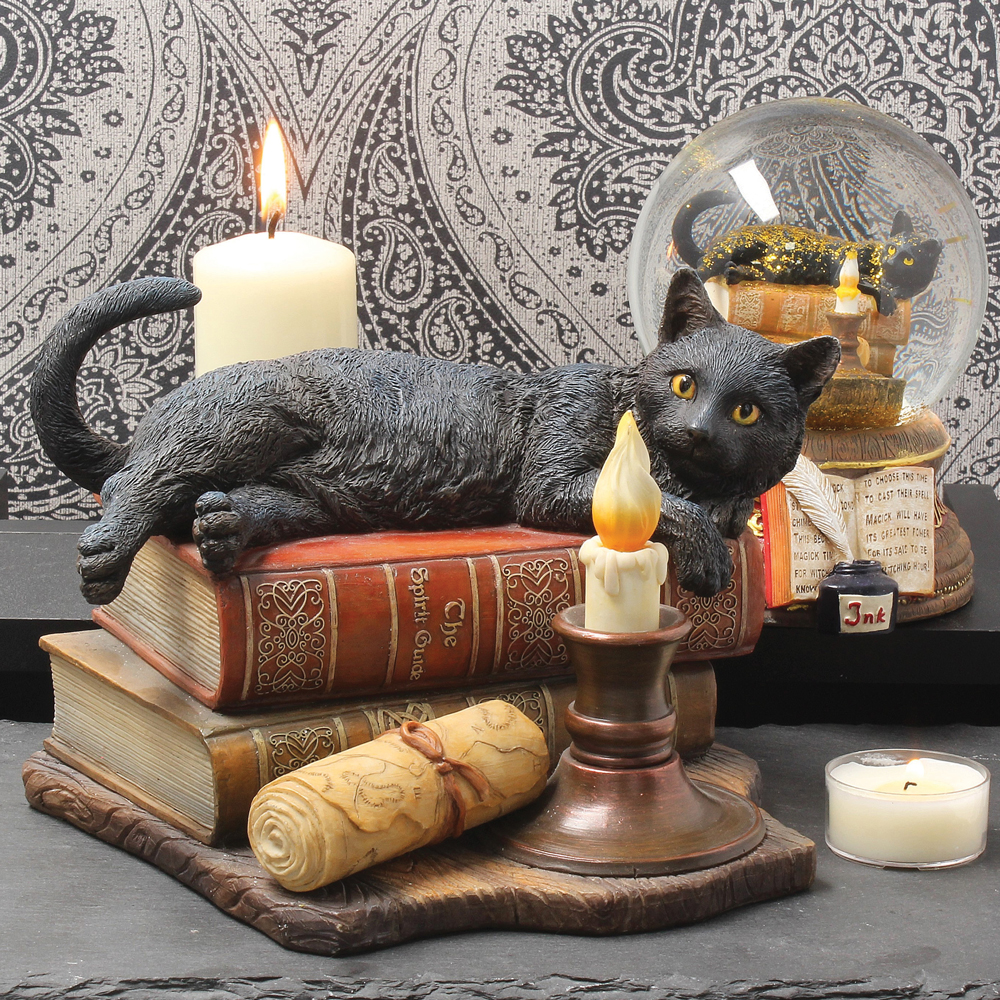Most of us look forward to the festive period, however, for cats Christmas may be a time of stress and risk of injury.
As a species cats enjoy routine and are sensitive to changes in their environment, making the celebrations challenging. In addition, the season means certain toxic plants and food may be accessible to curious cats. At International Cat Care we have consulted veterinary members to ask them what injuries they see at this time of year. Based on this information and with the input of the Veterinary Poisons Information Service (VPIS) this article offers advice on what to keep out of reach and what to do to minimise the disruption to keep our cats happy this Christmas.
Christmas plants
Poinsettia (Figure 1) is often mentioned as a potentially poisonous plant but its reputation is perhaps unfair. The Veterinary Poisons Information Service inform us that in over half the cases of pets eating Poinsettia plants reported to them, the cat or dog shows no signs of illness. Nevertheless it is still a good idea to keep the plant out of reach. In addition, Mistletoe, Holly, Ivy and Christmas Cherry can cause a tummy upset and should be kept away from inquisitive cats.

Figure 1: Poinsettia
Christmas trees
Many cat owners have had the experience of their cat climbing the Christmas tree and it falling over. Usually both are unharmed but it is worth considering securing the tree to avoid this. Injuries are reported from falling from Christmas trees and from the resulting smashed baubles, with glass ones particularly sharp when broken. Ingestion of Christmas tree needles and the fake snow applied to them can cause stomach upset and other decorations can be ingested resulting in a ‘foreign body’ (see later – abnormal material that can get stuck in the cat’s digestive system). Chewing of lights and wires can be a problem, especially for nosy kittens and it is not uncommon for cats to pass urine just where you don’t want them to i.e. the tree, potentially a problem if electric plugs and wires are exposed. This can be a sign of stress so read on for techniques to reduce the anxiety cats may suffer at this time of year.
Christmas food
At this time of celebration food may be left out with left-overs within reach. We traditionally worry about dogs and chocolate toxicity, but what about cats? Chocolate is also toxic to cats, although the amount a cat needs to eat to make them ill is a lot higher than for dogs. Signs of chocolate poisoning including being sick and passing diarrhoea, drinking a lot, appearing drunk, trembling or even having a fit. Hopefully a cat’s lesser interest in sweet treats means this risk is small.
Similarly, grapes and raisins, known for causing kidney damage in dogs, may affect cats but poisoning is much less common. The VPIS would however advise treatment of cats known to have eaten these foods, and suggest that for example mince pies are not left out. If you think your cat has eaten such food, contact your vet and encourage them to call the VPIS for advice. On the subject of food it may be tempting to treat your cat this Christmas, perhaps extra cat treats or some scraps from the Christmas dinner. While a little left-over turkey will be enjoyed by the majority of cats without harm, excessive treats and human food could make a cat poorly so do try and stick to their normal feeding routine at this time of year; they won’t know they are missing out! Another hazard can be cooked poultry bones – they are hard for cats to digest and can get stuck in the digestive system so make sure your cats can’t raid the bin after the Christmas lunch.

Seasonal candles
One of our vets reported seeing a cat with a singed tail from Hannukkah menorah candles and certainly exposed candles can be a hazard to cats who tend to jump onto windowsills and mantelpieces where candles are placed. As elevated locations are still accessible to most cats, candles should be kept where you can keep an eye on them or left off the Christmas list.
Festive foreign bodies
‘Foreign bodies’ is the term used to describe non-food items that have become lodged in a cat’s body, often the digestive tract, and we have looked at them in a previous topic in our Keeping Cats Safe campaign. They are less common in cats than in dogs, but we were surprised by the number reported by our veterinary members. When we asked them about Christmas hazards this was the most commonly reported medical issue linked to the season. ‘Linear foreign bodies’, those string or string-like materials causing a problem, appear to be the most common and so tinsel, lametta (the long decorative strips of tinsel) and string (around meat or used to hang decorations) were common culprits. One of our vet members reported removing a sticky mass of sellotape from a cat’s intestine in June that had been there since Christmas, evidenced by the adhered Holly leaves visible in places! As mentioned above, cooked poultry bones may also result in injury. If your cat is seen chewing the tinsel or any other string like material, prevent their access if possible and keep an eye on your pet for signs of illness. These signs can be subtle in cats and include simply sleeping more, hiding away and being sick or refusing food. Consult your vet if you are worried about your pet and do mention any non-food material you have seen your cat chewing.
How to make Christmas less stressful for cats
This time of year means lots of changes to a home, and for cats who often thrive on predictability, routine and the perceived safety of their territory (their home and garden), this can be distressing. The furniture is often moved around, the tree is brought in, lights and decorations are put up, music is played, all making their home look, sound and smell different. In addition, unfamiliar people, and worse still unfamiliar dogs, may visit the house or even stay, again at variable times, interrupting the normal routine. In order to minimise distress during this season consider the following:
- Ensure your cat has several safe and comfortable places to hide and get away from the noise and hustle and bustle. A cardboard box or igloo bed above the wardrobe or under the bed can provide security. If new beds are added to the home at this time, make them smell familiar by adding bedding already used by your cat.
- Advise visitors not to approach the cat if it is in its bed, but only to stroke the cat if it initiates contact. Visiting children may be keen to see and cuddle the cat but gentle stroking on the cat’s initiation must be insisted upon.
- Guests can be given cat treats and toys to help teach the cat positive associations with the new people.
- Ensure there is always an open door to allow the cat to get away from any noisy parties or dinners to a quieter part of the home.
- Consider plugging in a ‘Feliway’ diffuser into the room the cat spends most time in, several days before the festivities begin. This product (available from your vet) contains feline pheromones which can help the cat feel more secure. Ensure it is switched on continually throughout the festive season.
- If visitors are sleeping in one of the rooms the cat usually uses, for example, for sleeping, eating or toileting, be sure to provide the required resources (beds, food or litter tray) in other, quieter parts of the house and, ideally, before the visitors arrive so that changes occur gradually and the cat is comfortable with the new location.
- If the cat’s litter tray is positioned in a place that will mean more people traffic or noise during the Christmas period, it is good practice to provide an additional litter tray in a quieter part of the home.
- If the cat is particularly sound sensitive, avoid crackers and party poppers.
- If a dog is visiting it may be helpful to restrict its access to the cats retreat areas using, for example, baby gates on the stairs.
Conclusion
The Christmas season is a time for celebration but don’t forget your cat this year. Simple changes can keep them safe and make them feel more secure during the festive period.
References
- Volmer PA. 2002 How dangerous are winter and spring holiday plants to pets?Vet Med 97 (12):879-884.
- Marhold J. 1986 Prehled Prumyslove Toxikologie; Organicke Latky. Prague, Czechoslovakia, Avicenum, pp1372. Cited in: Theobromine. RTECS®: Registry of Toxic Effects of Chemical Substances. From MDL Information Systems, Inc. (electronic version). Thomson Micromedex, Greenwood Village, Colorado, USA.
- Gwaltney-Brant S. 2001 Chocolate intoxication. Vet Med96 (2):108-111.
Catch up with our past Keeping Cats Safe topics here.
Visit our Shop for Lisa Parker merchandise!
I am the feline behaviour specialist at feline charity ‘International Cat Care’. We are about engaging, educating and empowering people throughout the world to improve the health and welfare of cats by sharing advice, training and passion.

